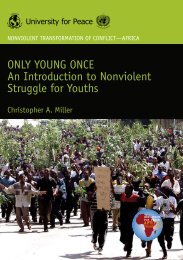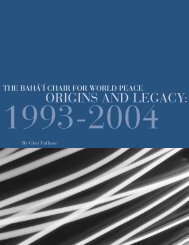IntroductionLAND tenure is the <strong>in</strong>stitutional framework with<strong>in</strong> which decisions are takenabout the distribution and use <strong>of</strong> land resources. It reflects the varied relationships<strong>of</strong> man to land. The actual structure varies with the status <strong>of</strong> theeconomy and society at a given time. Whatever the rules regulat<strong>in</strong>g the acquisitionand the use <strong>of</strong> rights <strong>in</strong> land, the dynamics <strong>of</strong> the economy and society tend tomodify these rules. Thus, land tenure is adapted to the economic and social conditions<strong>of</strong> the society. Through this process <strong>of</strong> adaptation, several forms emergedvary<strong>in</strong>g from traditional communal tenure, a feature <strong>of</strong> tribal societies, to privateownership, a feature <strong>of</strong> market exchange economies.Hence, traditional communal tenure is not static, but it is constantly adapt<strong>in</strong>gitself to the chang<strong>in</strong>g social structure and technical and economic requirements <strong>of</strong>the society. It is flexible and allows progressive reduction <strong>in</strong> the number <strong>of</strong> rightholders <strong>in</strong> a given piece <strong>of</strong> land <strong>as</strong> the result <strong>of</strong> social changes. Some years ago,there w<strong>as</strong> no need for exact determ<strong>in</strong>ation <strong>of</strong> land <strong>as</strong> there w<strong>as</strong> plenty for everyone.It w<strong>as</strong> only <strong>as</strong> pressure on land <strong>in</strong>cre<strong>as</strong>ed without sufficient <strong>in</strong>centive for <strong>in</strong>tensification,<strong>as</strong> markets developed, <strong>as</strong> new crops were <strong>in</strong>troduced and <strong>as</strong> human wantschanged that <strong>in</strong>terest <strong>in</strong> exclusive use became prom<strong>in</strong>ent. Hence, land use systemsare the result <strong>of</strong> adaptations to tenure systems that <strong>in</strong>fluence the use <strong>of</strong> sharedresources.With these views <strong>in</strong> m<strong>in</strong>d, this paper attempts to exam<strong>in</strong>e the evolution <strong>of</strong> landtenure <strong>in</strong> Darfur with the aim <strong>of</strong> identify<strong>in</strong>g the forces that operate to create deviationsfrom the traditional forms. It is <strong>as</strong>serted here that the traditional tenure <strong>in</strong>Darfur and land use forms have been considerably modified and adjusted to socialand economic requirements through a natural and spontaneous evolution while,on the other hand, <strong>conflict</strong>s arise <strong>as</strong> the result <strong>of</strong> regulations put <strong>in</strong> place by theGovernment that are contrary to the traditional systems.The Evolution <strong>of</strong> Land Tenure <strong>in</strong> DarfurThe land tenure systems <strong>in</strong> Darfur are the result <strong>of</strong> a long historical evolution andchang<strong>in</strong>g political, economic and social organisations. The present structures havetheir roots <strong>in</strong> the <strong>in</strong>stitutions and ways <strong>of</strong> life among the different tribal groups<strong>in</strong> the area. Each tribe acquired for itself a large territory <strong>of</strong> land (Dar). The Dar isregarded <strong>as</strong> the property <strong>of</strong> the whole tribe and the chief <strong>of</strong> the tribe is regarded<strong>as</strong> the custodian <strong>of</strong> the property. Land is allotted to every member <strong>of</strong> the tribe forcultivation purposes while unused land is left <strong>as</strong> a shared resource to be used byall the visitors (nomads).The Darfur Sultans did not change the b<strong>as</strong>ic structure, but they <strong>in</strong>troduced cer-58
ta<strong>in</strong> <strong>in</strong>novations called hakura (pl. hawakir) or landed estates that were recorded <strong>in</strong>written documents, wathiqa al-tamlik. This arose be<strong>cause</strong> high-rank<strong>in</strong>g <strong>of</strong>ficials andarmy commanders were not given regular salaries. Instead, the Sultan granted themlarge estates, hakura, to collect taxes and dues, ushur, from cultivators to susta<strong>in</strong>themselves. Some prom<strong>in</strong>ent figures and religious men were also granted estates<strong>as</strong> a means <strong>of</strong> obta<strong>in</strong><strong>in</strong>g their support. These changes played an important role <strong>in</strong>shap<strong>in</strong>g tenure arrangements. Land w<strong>as</strong> used <strong>in</strong> political barga<strong>in</strong><strong>in</strong>g and to w<strong>in</strong> thefavour <strong>of</strong> prom<strong>in</strong>ent tribal chiefs and <strong>in</strong>fluential men. In nomadic are<strong>as</strong>, particularlySouthern Darfur, communal ownership w<strong>as</strong> preserved.The colonial government w<strong>as</strong> able to stop the growth <strong>of</strong> neo–feudalist cl<strong>as</strong>s andrestored the communal ownership. The colonial government began regulat<strong>in</strong>g landby a series <strong>of</strong> ord<strong>in</strong>ances. In Darfur, where land w<strong>as</strong> held communally, the policyw<strong>as</strong> to avoid registration <strong>of</strong> <strong>in</strong>dividual rights. It recognized rights over land thatwere less than full ownership.Hence, the policies recognized three forms <strong>of</strong> land tenure. These are:1. Government lands with community rights.2. Government lands with no community rights.3. Hawakir (tribal or <strong>in</strong>dividual) and le<strong>as</strong>e (license).However, there w<strong>as</strong> no demarcation between the three forms. But the triballands, dars, were demarcated and mapped.Aga<strong>in</strong>st this background <strong>of</strong> uncerta<strong>in</strong>ty <strong>in</strong> relation to the ownership <strong>of</strong> unregisteredlands, the Unregistered Land Act <strong>of</strong> 1970 w<strong>as</strong> p<strong>as</strong>sed. This Act brought abouta dr<strong>as</strong>tic change <strong>in</strong> the concept <strong>of</strong> the ownership <strong>of</strong> unregistered land <strong>as</strong> ‘all land <strong>of</strong>any k<strong>in</strong>d whatsoever, whether unregistered, shall be the property <strong>of</strong> the governmentand shall be deemed to have been registered <strong>as</strong> such’, (El Mahdi 1971). This Actgives the local <strong>in</strong>habitants usufructuary rights. However, with<strong>in</strong> these governmentlands (accord<strong>in</strong>g to 1971 Act), customary tenure h<strong>as</strong> been modified and adapteditself to suit the chang<strong>in</strong>g conditions.At present, the forms <strong>of</strong> tenure practised dur<strong>in</strong>g the colonial period are to agreater degree still practised, but with some modifications. With<strong>in</strong> the customarytenure, <strong>in</strong>dividuals exercise different rights accord<strong>in</strong>g to established norms andcustoms. Accord<strong>in</strong>g to tradition, four scales <strong>of</strong> ownership exist:1. At the communal scale, each tribe h<strong>as</strong> a given land <strong>as</strong> a dar.2. With<strong>in</strong> the tribal dar, there is the clan ownership with a known boundary.3. At village level, there is the village land where each villager practises hisprivate ownership, which is respected by all.59
- Page 1:
ENVIRONMENTAL DEGRADATIONAS A CAUSE
- Page 4 and 5:
Cover Photo:AU forces patrol Darfur
- Page 7 and 8: PREFACEThese essays were originally
- Page 9 and 10: AcknowledgementsThe conference was
- Page 11 and 12: Executive SummaryByMary E. King and
- Page 13 and 14: the theme of the conference, outlin
- Page 15 and 16: • The question of warrior culture
- Page 17 and 18: Deryke Belshaw, University of East
- Page 19 and 20: area in West Darfur of 1.5m feddans
- Page 21 and 22: on the interaction between conflict
- Page 23 and 24: Conflict In DarfurHistorical andCon
- Page 25 and 26: distributive centre and where the r
- Page 28 and 29: sues quite separate. Evidence for t
- Page 30 and 31: FOOTNOTES1It is not my purpose here
- Page 32 and 33: 20On other emerging ethnically-base
- Page 34 and 35: IntroductionTHE Greater Darfur regi
- Page 36 and 37: 2. Agriculture (Farming)Crop farmin
- Page 38 and 39: Secondly, the demand for mutton and
- Page 40 and 41: groundnut and sesame as sources of
- Page 42 and 43: The situation of drinking water in
- Page 44 and 45: ReferencesConference, Meleet, North
- Page 46 and 47: IntroductionTHE residents of the Um
- Page 48 and 49: Phase Two:This phase was a monitori
- Page 50 and 51: zone southward — and to use these
- Page 52 and 53: • Some water points in places lik
- Page 54 and 55: This study and the seminar organize
- Page 57: Land Tenure,Land Use andConflicts i
- Page 61 and 62: mands for food production. All thes
- Page 63 and 64: Hashab Tenure SystemHashab ownershi
- Page 65 and 66: co-exist at the local level where e
- Page 67 and 68: IndigenousInstitutions andPractices
- Page 69 and 70: abs. In the past they had been invo
- Page 71 and 72: Sufi OrderSufi orders are religious
- Page 73 and 74: Native Administration, i.e. Tribal
- Page 75 and 76: Rizayqat homeland is at the extreme
- Page 77 and 78: esearchers and statesmen. A bigger
- Page 79: ReferencesBakheit, Jaafar M.Ali. 19
- Page 82 and 83: IntroductionWHILE in the Sudan prot
- Page 84 and 85: ReferencesHarir, S. 1993. ‘Arab B
- Page 86 and 87: IntroductionTHE Darfur Region lies
- Page 88 and 89: Table (1)Water program for Darfur 2
- Page 90 and 91: anging from 150mm the north and 450
- Page 92 and 93: ReferencesIbrahim, Abdel Rahman Abb
- Page 94 and 95: CONCLUSIONTHE collection of papers
- Page 96 and 97: GLOSSARYAjawidArdaBaqqaraDarDukhnFa
- Page 99 and 100: A Darfur Timeline99
- Page 101 and 102: 1898 On the eve of the battle of Om
- Page 103 and 104: Bibliography103
- Page 105 and 106: El Mahdi S. Mohamed. 1979. Introduc
- Page 107 and 108: Tothill, J.D. 1948. Agriculture in
- Page 109 and 110:
Biographical Sketch: Rex Sean O’F
- Page 111 and 112:
111











